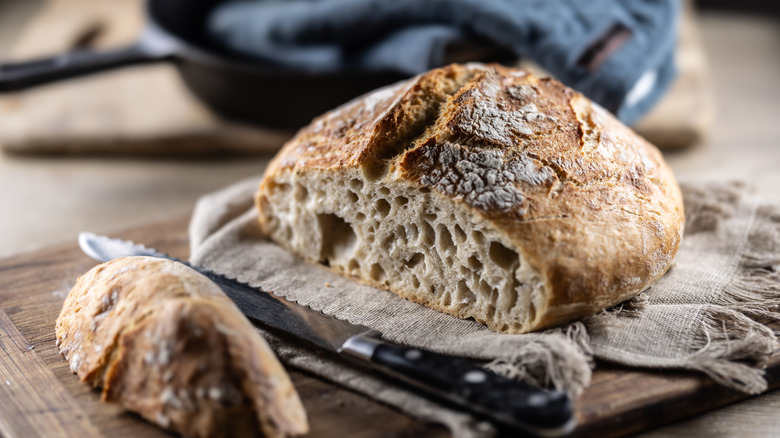Sourdough Vs White Bread: What's The Nutrition Difference?
Most everyone loves a delicious piece of bread, whether it's sliced for a sandwich or a roll to go with their meal. There are plenty of different types of bread in the U.S. and beyond, and they have more differences than you might think. You may be surprised to learn that sourdough and white bread, two of the most popular and tasty types around, have pretty different nutritional contents.
When comparing the same serving sizes, sourdough has a higher caloric content than white bread on average and more protein, while white bread typically has more fiber, and the two have roughly the same amount of fat. Sourdough generally has very little sugar, if any, while some types of white bread can have five grams per slice. Exact nutritional values will, of course, vary depending on a lot of factors, including brand and recipe. Consider all the differences that pop up between homemade versus store-bought breads, especially when you add extra ingredients like olive oil to homemade bread.
Sourdough bread is notably a good source of prebiotics and antioxidants thanks to its longer, more natural fermentation process. Prebiotics are widely considered to be very good for your gut health and microbiome and can aid digestion. These prebiotics come from the lactic acid formed from the starter, which helps break down the nutrients and destroy anti-nutrients like phytic acid, which can otherwise make absorbing other healthy compounds difficult.
Which bread is healthier?
Thanks to its long fermentation time, the nutrients in sourdough are broken down more, generally making sourdough bread easier to digest than white bread. It also contains less phytate, which makes its nutrients more available to your body. White bread is more processed than sourdough, which doesn't make it more unhealthy by default ... but in this case, the refined flour used to make it does mean that it lacks many of the vitamins and minerals found in less-processed types of bread like sourdough. This fermentation time also breaks down a lot of the gluten in sourdough bread, making it one of the few breads that many with non-celiac gluten sensitivity can eat at all (though people with celiac disease still cannot eat sourdough).
Sourdough also has a lower glycemic index, which means that the sugars it contains break down during digestion more slowly and don't cause the same kinds of blood sugar spikes that easily digestible ones like white bread do. In addition, many types of white bread have added sugar, whereas real sourdough does not.
What's "healthy" depends largely on your personal health and health goals. That said, sourdough tends to come out as the healthier of the two breads thanks to its nutritional content and the unique properties granted by its longer fermentation. Just take care that you're buying the real thing and not false sourdough made with yeast or other added ingredients. Real sourdough is made with only flour, water, salt, and starter.

